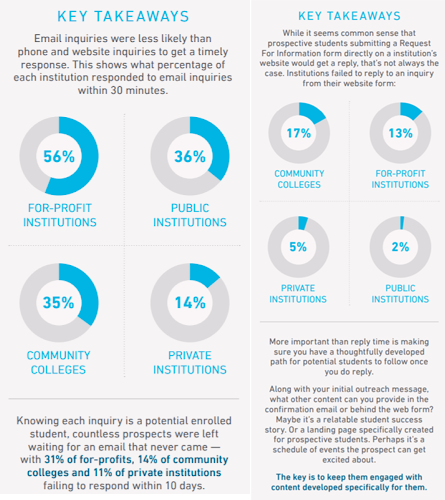Commentary
I stumbled across an opinion piece in EdSurge entitled “Burnout is Coming to Campus. Are College Leaders Ready?” The author, Kevin McClure, experienced burnout himself and interviewed Anne Helen Peterson, and others, on the subject. Peterson defined burnout as “when you get to a feeling of exhaustion with life. It’s not just physical or psychological exhaustion, it’s everything together. But instead of collapsing and saying, ‘I can’t do this anymore,’ you hit the wall and climb over it.” According to McClure, “A key part of burnout is continuing to work—perhaps even pushing harder—when you are exhausted.” McClure notes that the pandemic has resulted in a set of conditions that might make burnout more likely to occur among higher education professionals than prior to COVID-19. I found the concepts in this article relatable to a surprising degree in that they provided me with context for some of the things I have been experiencing in the last few months and hearing from other professionals. Most interesting to me was the explanation of the impact of the loss of the normal ebb and flow of work—particularly in higher education—and its relationship to burnout. The author also provides several recommendations for higher education leaders to address burnout, including: breaking the stigma around burnout, simplifying and reducing work if possible, evaluating and improving work conditions, and embracing flexibility.
AACRAO Research Update
Another Sneak Peek: Stranded Credits Another Perspective on the Lost Credits Story
ITHAKA S+R sponsored this research, and we are jointly releasing the full report in mid-September. “Stranded credits” refers to the accumulated credits for which a student is unable to obtain an official transcript due to an administrative hold. The sneak peek in last month’s blog was based on initial data, and I subsequently had to clean the data a bit, resulting in slightly different findings. Nearly all undergraduate-serving institutions in the United States withhold transcripts for one or more reasons, and more than half do so for an outstanding balance of less than $25. There are statistical differences in transcript withholding practices based on percentage of Pell recipients, institutional control and other characteristics.
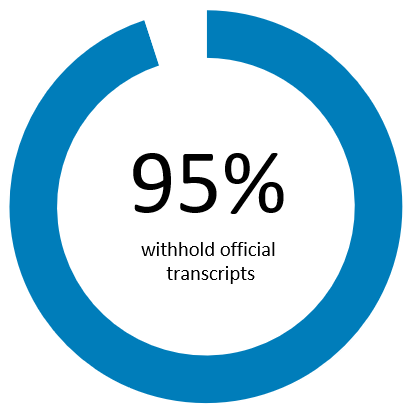
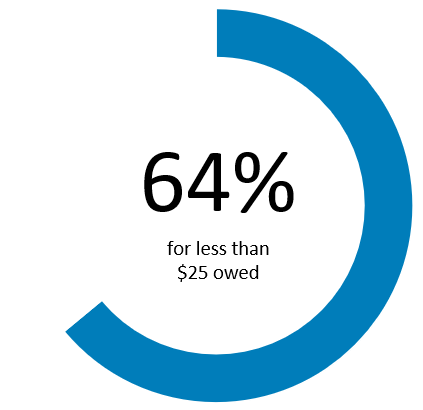
Most institutions are unable to measure the count and/or percentage of students impacted by these practices and, as such, are equally unlikely to be able to tabulate the average number of credits per stranded transcript and whether or not any particular student population is disproportionately impacted by the practice.
In Progress and Forthcoming
We are setting aside the September 60-Second Survey spot for a more comprehensive survey on the impact of the 2020 disruptions on work and career. It will be deployed on September 2nd and close on the 11th. Dr. Tom Green introduces the survey with the following: “The word ‘unprecedented’ is overused to describe this time in our history, but it is nonetheless accurate. Because of this, it is important to collect some data on how this period is affecting you personally and professionally.” The survey is as brief as possible. It asks about the pressures on you personally, the pressure on your organization, and the impacts these may have on your career. I would like to thank you in advance for your time if you should choose to complete the survey.
We suspended data collection on the Chief Enrollment Management Officer Career Profile Survey during the early COVID-19 impact on institutions. The current plan is to redeploy that survey on September 28th. The data from these two surveys will serve as a content guide for some of the upcoming SEM Conference presentations and panel discussion.
The data from the transfer evaluation practice and advising practice survey is being analyzed, and a report is forthcoming. The findings have been incorporated into the upcoming ACE and AACRAO joint webinar on September 9.
Current Higher Education Research and Related Topics
Digital Research Briefs on Digital Learning
Tyton Partners has released a series of comprehensive research briefs with links to related resources. These briefs are based on the findings of a national longitudinal survey, Time for Class, which focuses on learning tools with a goal of “increasing affordability and access.” The survey was started in 2014 and is repeated annually. The focus of the briefs are as follows:
Scaling digital learning
The relationship between the participation in and impact of faculty professional development and teaching modality
Adaptive learning via courseware
Impact on the approach to how adaptive courseware is adopted to faculty satisfaction with adaptive courseware
Inclusive access model use and challenges
Increasing student engagement through active learning practices
A Guide to Equitable Transitions from Secondary to Postsecondary Education During Pandemic Disruptions
The Education Commission of the States published six policy briefs on the transition between secondary and postsecondary education with special attention to underserved students:
Boosting FAFSA Completion to Increase Student Success
Establishing a State-Level Postsecondary Advising Network
Expanding High-Quality Work-Based Learning
Modernizing Math Pathways to Support Student Transitions
Policy Solutions that Foster Competency Based Learning
Prioritizing Equity in Dual Enrollment
Effective Nudging for College Students
A working paper from the Annenberg Institute at Brown University published in EdWorkingPapers summarizes an experimental study on the use of a chatbot at Georgia State University to provide proactive outreach. This outreach was designed to help undergraduate students embrace resources for academic support, social and career support, and navigating administrative processes. The experimental data supports the conclusion that “text-based outreach was most effective at influencing student behavior when its topical focus was on discrete, well-defined administrative tasks for which the consequences of inaction were high.” Examples of these tasks include addressing an unpaid bill or a registration hold. The researchers also found that the opt-out of messaging rates were higher if the message was perceived to not be from a trusted or expected source.
Assessment Related Changes In Response to COVID-19
The National Institute for Learning Outcomes Assessment (NILOA) summarizes the changes to assessment in response to COVID-19. The results of the June 2020 survey showed that most institutions made some type of change during spring 2020 in response to COVID-19. “Modifications to assignments or assessments and flexibility in assignment deadlines” were the most mentioned (see figure 1 from the report below).
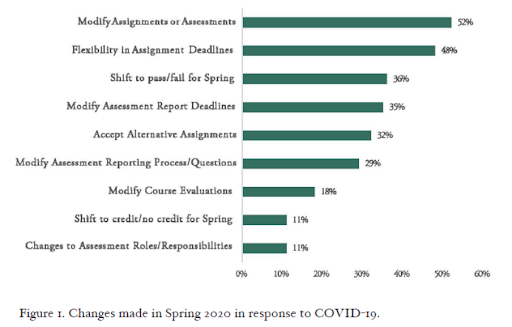
Source: Page 6 of https://www.learningoutcomesassessment.org/wp-content/uploads/2020/08/2020-COVID-Survey.pdf
In addition, there were differences in changes to assessment based on a measure of institutional inclusivity (see Table 1 from the report below).
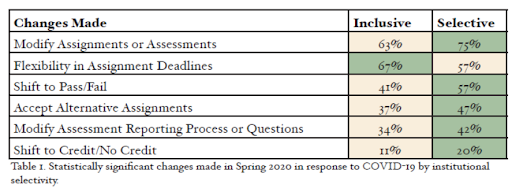
Source: page 7 of https://www.learningoutcomesassessment.org/wp-content/uploads/2020/08/2020-COVID-Survey.pdf
An Examination of the Responsiveness to Prospective Student Inquiries
Insidetrack enrollment experts posed as prospective students for two online programs at 113 institutions with a strong online presence and of varying characteristics. Their findings include: emails were least likely to get a response; phone calls were responded to faster than other avenues; several completed request for information forms received no responses; and texting was underutilized. Their data includes time to response, response format and other key data disaggregated by institutional characteristics. Key takeaways from the email inquiry and request for information form are included in their report figure below. Please see the report for their comprehensive findings and recommendations.
